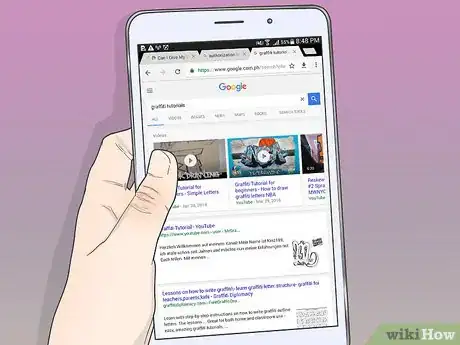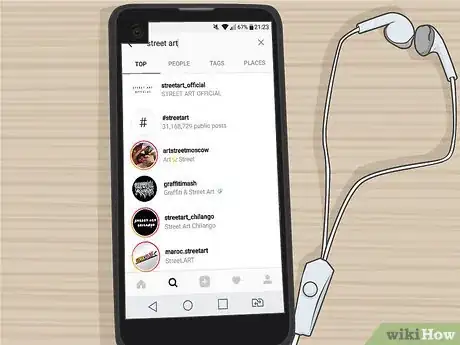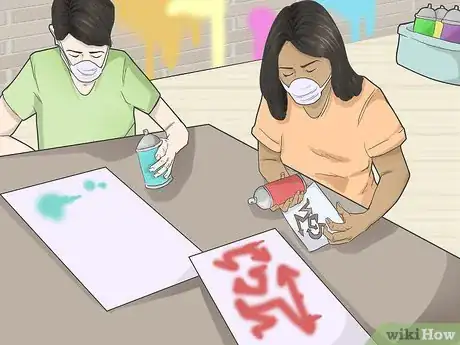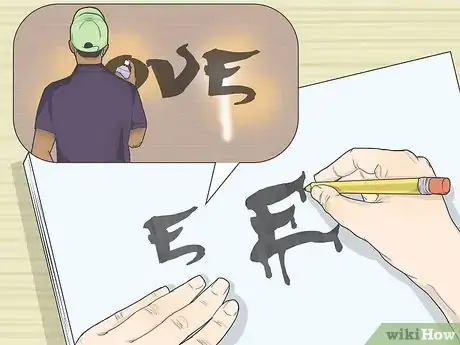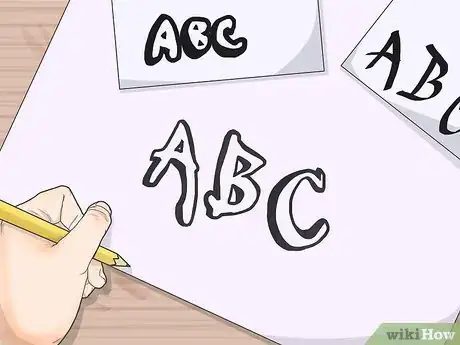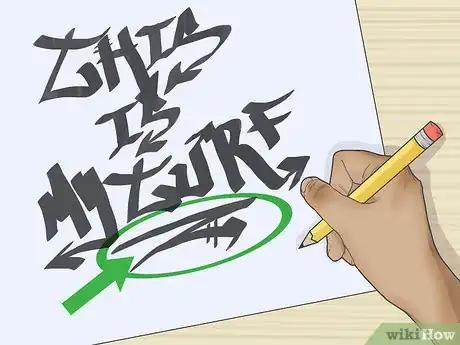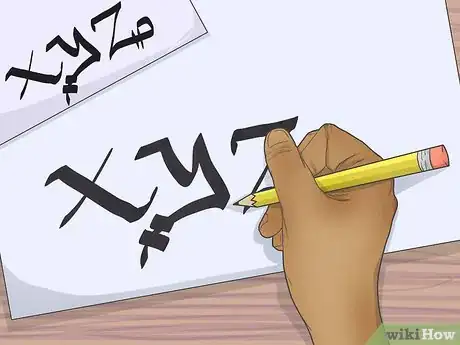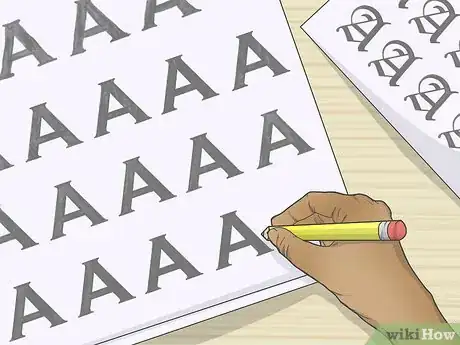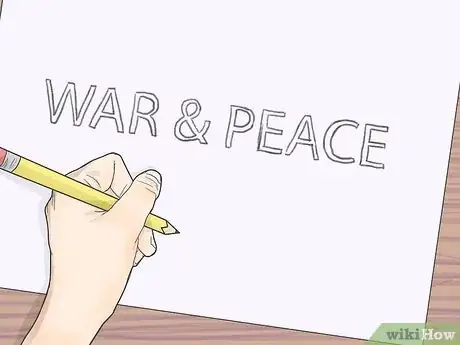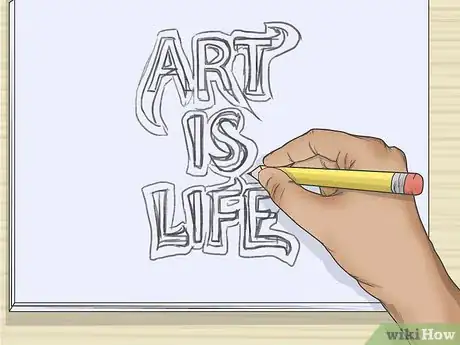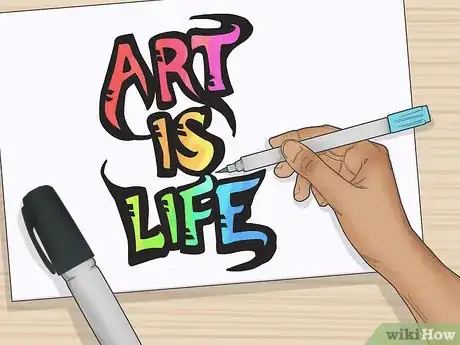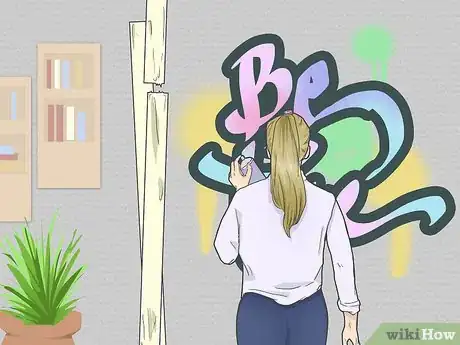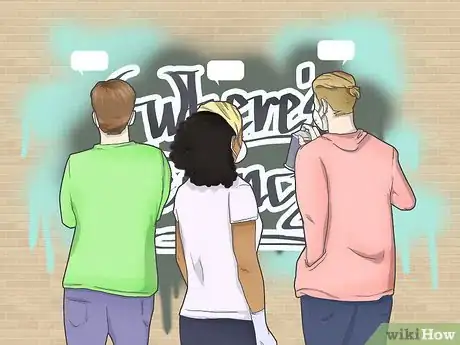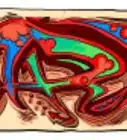This article was co-authored by wikiHow Staff. Our trained team of editors and researchers validate articles for accuracy and comprehensiveness. wikiHow's Content Management Team carefully monitors the work from our editorial staff to ensure that each article is backed by trusted research and meets our high quality standards.
There are 12 references cited in this article, which can be found at the bottom of the page.
This article has been viewed 80,164 times.
Learn more...
Although painting someone else’s property without permission could land you in trouble with the law, graffiti has long been a popular way of expressing social and political messages. The first step in creating your own style is getting some inspiration from local artists or online. After that, you’ll be ready to practice with paper and some markers. Once you’ve got the basics down, you can improve your ability with things like calligraphy and stencils.
Steps
Getting Inspiration
-
1Scope out local graffiti. Graffiti is fairly common in urban locations, but if you don’t live close to a city, try looking for graffiti on trains.[1] Train cars are common targets for graffiti. Take a sketch book with you to your local train station and copy down your favorite designs and styles.
- If you’re just starting out, a quick sketch might be difficult to complete before the train leaves. In this situation, snap a picture with your phone.
- Some locations, like overpasses, tunnels, and alleys, are hotspots for graffiti. Take note of these places and visit them regularly so you can see real graffiti in person.
-
2Look up graffiti styles online. Graffiti has evolved over the years into a popular art form that people reproduce on paper, shirts, and canvas. Because of its popularity, there are many sites that offer free tutorials on graffiti basics. Find these sites with an online search for “how to draw graffiti.”
- Many sites have free printouts with basic graffiti scripts. Use these as a template or trace the letters to get a better feel for drawing them.
- YouTube is a great resource for seeing graffiti in action. Subscribe to the channels of active artists so you can follow along with new projects as they’re released.
Advertisement -
3Follow graffiti artists on social media. Search Facebook for local graffiti groups with something like, “Chicago graffiti groups.” Before joining a group, check its recent history to make sure it’s active. Look for graffiti artists and their fans on Instagram with a search for “graffiti” or “street art.”
-
4Take a class on street art. Street art is the academic term usually used for graffiti. Graffiti has existed since ancient times, so there are many historical examples that might spark an idea for your own style. You could also bring in some of your practice graffiti and ask your teacher for some pointers.
- Community colleges, community centers, and art schools frequently offer courses in street art. Search online for “street art classes near me” or “graffiti classes near me.”
- Museums and galleries sometimes showcase exhibits dedicated to street art. Visit or call your local museums and galleries to inquire about street art shows.[2]
-
5Borrow from your favorite artists. In the words of the famous artist Pablo Picasso, “Bad artists copy, great artists steal.”[3] This doesn’t mean you should rip off someone else’s style. Instead, take the aspects you admire in the art of others and make it your own by incorporating it in your style.
- For example, if you really like how a certain artist writes their T, substitute it for your natural T. By borrowing letters from various artists, you can build a unique script all your own.
- You don’t have to copy the style you like exactly. Tweak letters in whatever way feels natural to you. Try drawing them elongated, on a slant, or upside down.[4]
-
6Combine styles to create unique variations. Even more unique variations can be created by combining two different styles. For example, you could combine the thick lines of one style with the slanted orientation of a different one.
- Try alternating between two scripts with every letter you write. Use a different script for vowels to create an offset effect.
-
7Embellish your graffiti with themes. If you go by the graffiti name “Bolt” you could decorate your letters with lightning bolts and crackling electricity. The message, “This is my turf,” might look interesting with a grass motif.[5]
- Repeated themes, like sparks from electricity, can often be added easily with the use of a stencil.
Developing Your Style
-
1Gather your tools. To practice, you’ll need plenty of paper, some pencils, and a variety of markers. Scissors and utility knives come in handy when making stencils. Thick, heavy marker pens, like a king-sized Sharpie, are often used in graffiti.[6]
- Marker pens can sometimes bleed through your paper and stain your writing surface. To prevent this, use scrap paper, cardboard, or an art mat under your paper.
-
2Get the hang of the basics. Look up pictures of graffiti on the Internet and try to imitate them with pencil and paper. Trace penciled letters in marker pen. This will improve your hand-eye coordination as well as your muscle memory of basic graffiti shapes.
- As you improve, start adding personal flair to your graffiti. For example, your style might naturally use bubble letters or sharply defined letters with thick lines.
-
3Master entire scripts. A script is a single style of writing the alphabet and numbers. Some common scripts include Gothic, Uncial, and Copperplate.[7] Write a single letter over and over again until it looks good, then move on to the next one. When you know the script reasonably well, write out the entire alphabet in the script.[8]
- Some sites offer free printouts of entire scripts. Use these as a template when practicing.
- When a script is mastered, it’ll be less difficult for you to insert single letters from that script into your personal style.
- Remember to practice upper and lowercase letters. Much graffiti is written in all caps, but you never know when you’ll need lowercase letters for stylistic effect.[9]
-
4Use simple scripts as the basis for more complicated designs. Lightly draw some block letters in pencil on a blank page. If anything looks off, use a quality eraser to remove whatever doesn't quite work. In this fashion, redraw and refine your design until you’ve got something you like.[10]
-
5Modify simple scripts to experiment with designs. Erase some parts of the block letters you drew and add arrows, cracks, bubbles, dents, stars, chips, and whatever else you think might look good. Try to keep one style per word or sentence. Mixing up styles can make your graffiti look too busy.
- By overlapping one letter with its neighbor, you can give your graffiti the illusion of depth. The overlapping letter will look like it’s in front of the other one.
- It’s very common for graffiti letters to lead into the following letter on the right to create a jigsaw effect where letters are squished together with little to no space in between.[11]
-
6Ink your modified simple script. When you are done perfecting your block lettering, use a black or blue marker to outline the block letters.[12] Feel free to add color to the insides of letters with highlighters, Sharpies, crayons, and colored pencils.
Improving Your Style
-
1Use a wall in your home for realistic practice. A blank wall in your home is a great place to practice graffiti. Try writing the scripts you practiced with spray-paint, paint and paintbrushes, and marker pens. When the paint dries, you can paint over it with a new design to continue practicing.
- If you’re self-conscious about your practice, choose an out-of-sight wall, like one in your basement or behind your house.
- If you don't have the option of working directly on a wall, put up some thick paper and practice on that instead.
- After practicing like this for a while, thick layers of paint will build up on your wall. This can negatively impact the quality of your practice. Remove old paint by sanding it away and keep on practicing.
-
2Learn and practice calligraphy. Calligraphy is the art of writing decorative letters. The many unique scripts in calligraphy can also be used in your graffiti. Calligraphy starter kits can be found at most hobby shops, craft stores, and through online sellers.
- Due to the crossover between calligraphy and graffiti, graffiti scripts that are especially ornate are sometimes called “calligraffiti.”
-
3Invent your own unique tag. A tag is your graffiti signature. Many graffitists tie major themes in their work together together with their tag. For example, if peace and harmony are important to you, you might dot i's in your name with peace signs.[13]
- Some tags may be unreadable, but a legible tag will help people identify your work more easily. Tags may change slightly over time, but generally they stay consistent.
- Artists with a more surreal style might make it look like the end of their name is melting, similar to the surrealist paintings of Salvador Dali.
- Graffitists with an environmental passion could decorate their signature with a leaf stencil overlaid with a few brightly colored stenciled flowers.
-
4Collaborate with other graffiti artists. Working with another graffiti artist can build up your skills. Your partner can give you advice or show you techniques to improve your weak areas, and vice versa. Additionally, you and your partner will likely be able to finish larger pieces in less time, gaining you experience more rapidly.
- You might be able to find someone to collaborate with by proposing a project on a Facebook graffiti group wall or a street art website message board.
-
5Make and use stencils. Stencils aren’t a crutch; many graffiti masters (like Banksy) frequently use stencils in their work. By layering different colors of paint with stencils, you can create complex designs with a high level of detail.
- Hold onto stencils that turned out especially well. Down the road, if you want to reproduce the design, you won’t have to remake the stencil.
- A simple layered design can be made by spraying a leaf and vine stencil with green paint. Once that dries, spray a simple flower stencil on top to make a blooming vine.
- Consistently using a stencil combination that jives with your style can be a great way of gaining recognition and visibility.
Warnings
- Doing graffiti on a structure without the owner’s permission could result in a police fine or worse. Always be respectful of the property of others.⧼thumbs_response⧽
Things You’ll Need
- Paper
- Pencil
- Eraser
- Marker pens (like felt-tipped markers)
- Spray paint
- Paint (and paintbrushes)
- Stencils
References
- ↑ https://www.youtube.com/watch?v=ta0iTOv7JV4&feature=youtu.be&t=5m25s
- ↑ https://ajammc.com/2013/09/17/word-as-image-contextualizing-calligraffiti-1984-2013-with-french-tunisian-street-artist-el-seed/
- ↑ https://quoteinvestigator.com/2013/03/06/artists-steal/
- ↑ https://www.youtube.com/watch?v=ta0iTOv7JV4&feature=youtu.be&t=1m4s
- ↑ https://www.youtube.com/watch?v=1VJM-RB9F1A&feature=youtu.be&t=4m30s
- ↑ https://www.youtube.com/watch?v=ta0iTOv7JV4&feature=youtu.be&t=4m25s
- ↑ http://www.calligraphy-skills.com/calligraphy-alphabets.html
- ↑ https://www.youtube.com/watch?v=1VJM-RB9F1A&feature=youtu.be&t=2m52s
- ↑ https://www.youtube.com/watch?v=ta0iTOv7JV4&feature=youtu.be&t=7m4s
- ↑ http://www.hellokids.com/c_29729/drawing-for-kids/drawing-video-tutorials/draw-letter-a-in-graffiti-style
- ↑ https://www.youtube.com/watch?v=ta0iTOv7JV4&feature=youtu.be&t=4m47s
- ↑ http://www.hellokids.com/c_29729/drawing-for-kids/drawing-video-tutorials/draw-letter-a-in-graffiti-style
- ↑ https://www.youtube.com/watch?v=1VJM-RB9F1A&feature=youtu.be&t=4m28s

